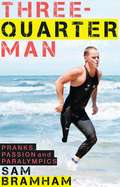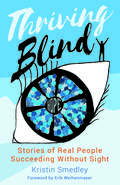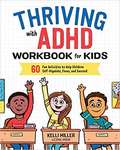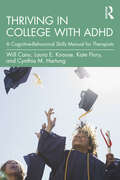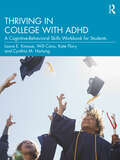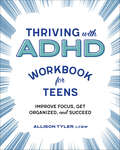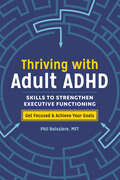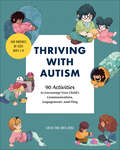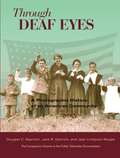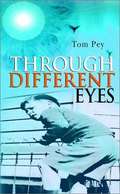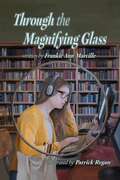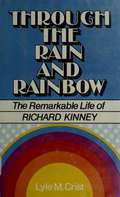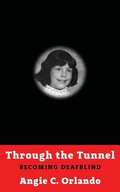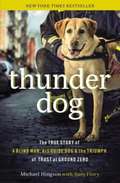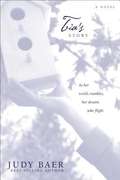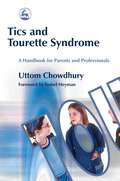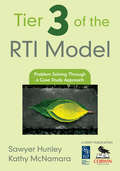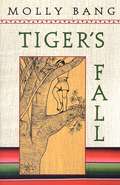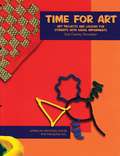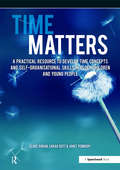- Table View
- List View
Three-quarter Man
by Sam BramhamBramham doesn't let a disability slow him down, or quell his larrikin streak. He's a force of nature, as famous for making mischief as for winning Paralympic medals in the pool. Despite an 'international incident' or two, Sam was awarded an Order of Australia Medal for being an inspiration and role model. With his competitive spirit still burning, Sam is on the road to Rio, determined to win gold for Australia in the first ever Paralympic triathlon.
Thriving Blind: Stories of Real People Succeeding Without Sight
by Kristin SmedleyBlindness. A tough topic to discuss? Not anymore. In this groundbreaking book, readers will see blindness in a whole new light. In fact, the compelling and entertaining stories will not only change perceptions of blindness, they’ll make readers forget the people featured are actually blind. Author Kristin Smedley’s journey began with devastation and tears after her two sons were diagnosed as blind when they were each just four months old. Eventually, she met a few people who would change her perception of what is possible for those navigating the world without sight. Those role models were the tipping point for Kristin and her sons to move from surviving blindness, to thriving. Thriving Blind introduces the reader to thirteen of those pivotal people--including a reality tv star, YouTube sensation and Teacher of the Year! While the stories in Thriving Blind demonstrate how blind people used creativity and determination to live the life of their dreams, the lessons they convey about facing fears and crashing through society’s barriers are transformative for all who experience struggles. Kristin herself applied these lessons to her own journey. She has testified at the FDA for the first ever treatment for vision loss, coordinated the first legislation in US history to be submitted in Braille, and is a highly influential voice around the world for those living with rare eye diseases. Thriving Blind will transform your idea of what is possible for people who encounter a devastating disability or life challenge and will catapult your motivation to set extraordinary expectations for your own life.
Thriving With ADHD Workbook For Kids: 60 Fun Activities To Help Children Self-regulate, Focus, And Succeed
by Kelli MillerWith the right tools, kids can learn to think positively about their ADHD and see it as a special asset. Thriving with ADHD is filled with easy exercises to help your child with the many facets of ADHD, from self-control and organization to getting tasks done and making friends―so they can flourish at home, school, and beyond. <P><P> Kids will learn to reframe the way they think about ADHD as they discover their own unique talents. With fun activities that engage their busy minds, this workbook offers a strength-based approach to help your child gain a better understanding of themselves, their ADHD, and the simple things they can do to feel more confident and in control. <P><P> This ADHD workbook for kids includes: An overview of ADHD―Teach your child about common symptoms, different ADHD types, and how ADHD can be an advantage. Skill-building exercises―Establish key executive functioning skills, like dealing with anger and frustration, staying focused, controlling impulses, and communicating effectively. Action-oriented learning―Help kids thrive in their daily lives with fun lessons for creating a morning routine, making a homework chart, expressing themselves when they’re upset, and more. Show your child how to harness their unique gifts and live life to the fullest with their ADHD―this practical workbook will help guide the way.
Thriving in College with ADHD: A Cognitive-Behavioral Skills Manual for Therapists
by Laura E. Knouse Will Canu Kate Flory Cynthia M. HartungThriving in College with ADHD uses cognitive-behavioral and psychoeducational techniques to address ADHD and related impairment in a way that is tailored to the needs of college students. This manual distills the expertise of four psychologists with extensive experience helping students with ADHD. The treatment is designed to be effective, flexible, and feasible. Modules address organization, time management, planning, and academic skills, adaptive thinking, healthy lifestyles, relationships, and other life skills. They can be used with individuals or groups and as an abbreviated or comprehensive treatment, tailored to client needs. The accompanying student workbook will increase the treatment’s impact and keep college students engaged in learning new skills. Any mental health professional working with college students with ADHD can benefit their clients by adding this approach to their toolbox.
Thriving in College with ADHD: A Cognitive-Behavioral Skills Workbook for Students
by Laura E. Knouse Will Canu Kate Flory Cynthia M. HartungDeveloped by four professors who also happen to be ADHD experts, this interactive and customizable workbook provides coaching to students with ADHD to make skills like managing time, motivating and organizing oneself, and "adulting" a workable part of everyday college life. Other books for college students with ADHD only describe personal experiences or just give advice, but this workbook promotes learning through interactive exercises and behavioral practice. It will allow you to address issues most relevant to your needs at whatever pace feels right. Modules are designed to be engaging, digestible, and activity-oriented. With practice, you will come away with improved skills that will help you to succeed in college, and to live your best life. This workbook can be used on its own; however, an accompanying Thriving in College guide for therapists uses an approach that mirrors what you will be learning and doing. If you have this workbook and are getting support from a therapist, encourage them to use the therapist guide along with you! Parents can also benefit from information in this workbook, to help their college students along the way and to understand ADHD and how it impacts the college years.
Thriving with ADHD Workbook for Teens: Improve Focus, Get Organized, and Succeed
by Allison TylerBuild focus, organization skills, and self-confidence with this supportive ADHD workbook for teens ages 12 to 17Does it feel hard to stay organized sometimes? Do homework assignments sneak up on you? Having ADHD can feel overwhelming, but the Thriving with ADHD Workbook for Teens gives you the tools to understand how ADHD works, and actionable ways that you can use it to your advantage. Learn about some of your untapped strengths and see how you can channel your newly identified talents at school, in sports, and with friends.Inside this ADHD workbook for kids 12 to 17 you'll find:Ways to get to know your brain—This ADHD book for kids and teens helps you understand how your executive functioning skills work to help you organize, plan, react, and more.Frequently asked, always answered—Go beyond other books for kids with ADHD with a Q&A section that provides answers to common questions that young people with ADHD often ask.Advice you can use—Discover everyday tools that give you simple but effective strategies for approaching routine things like homework, hobbies, chores, relationships, and more.Learn how you can thrive with ADHD through the engaging activities in this ADHD book for teens.
Thriving with Adult ADHD: Skills to Strengthen Executive Functioning
by Phil Boissiere MFTProven strategies for strengthening executive functioning skills and overcoming adult ADHD symptomsExecutive functioning skills—including focus, organization, stress management, and more—are critical to succeeding in all aspects of your life. Whether you've just been diagnosed with ADHD or you've lived with it your entire life, you know that developing these skills can be a challenge. Thriving with Adult ADHD offers information, assessments, and evidence-based exercises to help you build a mental skill set and take control of your ADHD.Make real, sustainable changes with practical guidance and activities for sharpening your memory and attention, learning to plan and organize, strengthening your mental flexibility, enhancing your emotional regulation, improving your impulse control, and living your best life.This ADHD book for adults includes:Executive functioning overview—Learn what executive functioning is, how it relates to ADHD, and how these exercises can help you develop it.Solutions for all settings—Discover actionable advice for managing ADHD symptoms at home, at work, and in relationships.Self-assessments—Identify your personal strengths and weaknesses with quick self-evaluations.Don't let ADHD symptoms hold you back. Gain the skills you need to achieve your goals with help from Thriving with Adult ADHD.
Thriving with Autism: 90 Activities to Encourage Your Child's Communications, Engagement, and Play
by Katie CookHelp children with autism strengthen their connections—supportive strategies for ages 1 to 11To guide your efforts to help your child flourish, this book has 90 playful, evidence-based activities. Thriving with Autism provides an easy, effective toolbox to supplement and support the developmental work parents and caregivers are doing with their children. These solutions are designed for kids with autism from ages 1 to 11. The benefits can last a lifetime.From building better conversation abilities to strengthening social skills, Thriving with Autism delivers practical, everyday ways to connect, encourage, and play. Featuring exercises like Acts of Friendliness, The Human Burrito, and Emotional Charades, this comprehensive guide encourages your child with autism to boost their communication, engagement, and self-regulation skills.Thriving with Autism includes:Hands-on activities—Make learning fun with lots of lessons that can help kids across the autism spectrum.Simple strategies—Tackle these easy, research-driven activities one by one at home.Engaging and practical—Find helpful tips and suggestions, as well as full-color illustrations that are sure to inspire and delight you and your child.Now there's a smart, sensible way to help teach kids with autism necessary skills.
Through Deaf Eyes: A Photographic History of an American Community
by Jack Gannon Douglas Baynton Jean Lindquist BergeyHistory Through Deaf Eyes, an exhibition based on the lives of deaf people in the United States, toured the country from 2001 to 2006. During its twelve-city tour, more than 415,000 people visited the exhibit and learned of the struggles and triumphs of the Deaf community, a cultural, linguistic minority within the larger hearing population. The impetus for History Through Deaf Eyes came from Gallaudet University, the only university in the world founded specifically to provide higher education to deaf and hard of hearing people. Gallaudet is a cultural home to many deaf people. Studying the lives of deaf people illuminates not only a minority community but also the majority hearing population. Through the story of deaf America we learn much about our broader history. For both deaf and hearing readers, the history of the Deaf community offers a unique and fascinating perspective on the workings of human difference.
Through Different Eyes
by Tom PeyAt age 38, a childhood accident came back to haunt Tom Pey and took his sight. Follow his struggle with depression, job loss and alcoholism. Follow his success as he finds a deeper meaning in life.
Through Otis's Eyes: Lessons from a Guide Dog Puppy
by Patricia Burlin Kennedy Robert ChristieFrom the book jacket: "This admirable little puppy helps us to see past our busy daily lives and to focus on what's enduring and important. guiding eyes for the blind enthusiastically recommends this work..." RICHARD ABBOTT, VICE PRESIDENT Guiding Eyes for the Blind, Inc. This delightful book is not completely accessible to those with print disabilities with the aid of picture descriptions.
Through the Eyes of Aliens: A Book About Autistic People
by Jasmine Lee O'NeillThe author, who describes herself as a person with autism, describes this condition as rare and beautiful. She offers suggestions to parents, teachers, and caregivers, encouraging them to respect the autistic person's uniqueness and wholeness. She urges that autistic people should be accepted for who they are, and that efforts to change them and rid them of autism are futile and painful for everyone concerned.
Through the Magnifying Glass
by Patrick Regan Frankie Ann MarcilleJulia is just your average middle schooler. She loves spending time with her family and friends, reading, and listening to music or podcasts. She especially loves listening to old-school Sherlock Holmes radio shows on YouTube. But Julia doesn't feel like everyone else. Having a vision impairment sometimes makes her feel like she doesn't fit in anywhere. She's not totally blind, but she's not sighted either. Her family and teachers for the blind encourage her to use adaptive devices, like a white cane, or assistive technology, like a screen reader, to help her, but Julia has no interest. She wants to be just like everyone else, specifically her older brother, John, the town hero, most popular guy in high school, mystery-solving, John.
Through the Rain and Rainbow: The Remarkable Life of Richard Kinney
by Lyle M. Crist<P>Richard Kenny lost his sight at age seven. He spent his childhood adjusting to and overcoming blindness. He entered college but had to drop out in his second year when his hearing failed. <P>The next ten years contained motes of both great anguish and sweet victory as he adjusted to being totally deaf-blind. With perseverance, the support of family and friends, and the counsel of such leaders as Helen Keller and other workers for the deaf and blind, Kenny became the third deaf-blind person in history to earn a college degree. He married, became a father, traveled and wrote.
Through the Tunnel: Becoming DeafBlind
by Angie C. OrlandoUsing a mixture of prose and poetry, Angie C. Orlando shares indelible stories about growing up in a small Ohioan town, complete with posing for family pictures, watching high school football games, and playing saxophone in a marching band. Yet she is equally funny and unflinchingly honest about how classmates, medical professionals, and others have viewed her multiple disabilities, all of which had gradually became apparent over time. Through it all, she leaves her abusive husband and endures her brother's suicide to become her own person.
Thunder Dog: A Blind Man, His Guide Dog, and the Triumph of Trust at Ground Zero
by Michael Hingson Susy FloryA blind man and his guide dog show the power of trust and courage in the midst of devastating terror. It was 12:30 a. m. on 9/11 and Roselle whimpered at Michael's bedside. A thunderstorm was headed east, and she could sense the distant rumbles while her owners slept. As a trained guide dog, when she was "on the clock" nothing could faze her. But that morning, without her harness, she was free to be scared, and she nudged Michael's hand with her wet nose as it draped over the bedside toward the floor. She needed him to wake up. With a busy day of meetings and an important presentation ahead, Michael slumped out of bed, headed to his home office, and started chipping away at his daunting workload. Roselle, shivering, took her normal spot at his feet and rode out the storm while he typed. By all indications it was going to be a normal day. A busy day, but normal nonetheless. Until they went into the office. In Thunder Dog, follow Michael and his guide dog, Roselle, as their lives are changed forever by two explosions and 1,463 stairs. When the first plane struck Tower One, an enormous boom, frightening sounds, and muffled voices swept through Michael's office while shards of glass and burning scraps of paper fell outside the windows. But in this harrowing story of trust and courage, discover how blindness and a bond between dog and man saved lives and brought hope during one of America's darkest days.
Tic Disorders: A Guide for Parents and Professionals
by Tara Murphy Uttom Chowdhury Suzanne DobsonThis is the essential one-stop guide for parents of children and young people with tic disorders and the professionals who work with them. Drawing on current research and their own clinical experience, the authors provide up-to-date information on tic disorders and review the psychological, medical and alternative methods of managing symptoms. Written in clear, accessible language and with practical advice on how to support children with tics at home and in school, the book also includes essential information on the common co-occurring conditions and difficulties, such as ADHD, anxiety, OCD, autism, self-esteem issues and behavioural difficulties.
Tics and Tourette Syndrome: A Handbook for Parents and Professionals
by Uttom ChowdhuryThis essential guide to tic disorders and Tourette Syndrome tackles problems faced both at home and at school, such as adjusting to the diagnosis, the effect on siblings and classroom difficulties. Dr Chowdhury offers advice on how to manage symptoms, describing practical techniques such as habit reversal and massed practice and reviewing available medical treatments. In clear, accessible language, this book explains the clinical signs and symptoms of Tourette and related conditions, and their possible causes. Presenting strategies for dealing with associated difficulties, including low self-esteem, anger-management and bullying, this book will be invaluable to parents, teachers, social workers and other professionals.
Tier 3 of the RTI Model: Problem Solving Through a Case Study Approach
by Sawyer Hunley Kathleen M. McNamaraIdentify students’ learning needs and make appropriate decisions regarding instruction and intervention! Written for RTI teams, this resource demonstrates how to conduct intensive, comprehensive evaluations of students who are struggling in the general classroom. Focusing exclusively on the third tier of the RTI model, the book: Provides guidance on problem identification and analysis, progress monitoring, selection of research-based interventions, and evaluation of case study outcomes Addresses both academic and behavioral challenges, including mental health issues Shows how school psychologists can collaborate with other members of the RTI team Provides tools for assessment and for tracking progress
Tiger's Fall
by Molly Bang<P>A feisty little girl learns that physical disability can't limit her ability to make a difference. <P>Lupe loves nothing better than riding her father's horse, El Diablo. Fearless and agile, she rampages around her rural village in Mexico like a tigrilla (little tiger), which is her father's nickname for her. But one day Lupe falls while climbing a tree. Paralyzed from the waist down, she will never again be able to ride El Diablo. Her life might as well be over, she thinks. At first Lupe is filled with rage and self-pity. Her family brings her to a center run by and for disabled people, to recuperate. Despite the evidence around her, she refuses to believe that disabled people can be happy and self-sufficient, and she can't believe that these people think their lives are worth living. But slowly the people and the spirit of the center help Lupe realize that she, too, has something to offer. <P> Award-winning author/illustrator Molly Bang brings emotional honesty and bravery to this compelling, fact-based story of coming to terms with disability.
Tilt: Every Family Spins on Its Own Axis
by Elizabeth BurnsThe story of a mother coming to terms with her daughter's autism and her husbands's manic-depression
Time For Art: Art Projects and Lessons for Students with Visual Impairments
by Gail Cawley ShowalterThis simple manual gives some helpful suggestions for people who want to teach art to children who are blind or visually impaired. It also gives some suggestions on projects that the students can do. It is not intended as the "all around authority" on the topic but serves as a spring board into other projects and ideas. Topics and projects include, fake fossils, aluminum repousse, papier mache bowls, wire sculptures, and raised line drawings. Good book for anyone interested in ways to adapt lessons in art for learners with special needs. Also includes art projects which relate to science.
Time Matters: A Practical Resource to Develop Time Concepts and Self-Organisation Skills in Older Children and Young People
by Janet Pembery Clare Doran Sarah DuttTime Matters is a practical resource to help children and young people learn about time. Time is usually taught through the Primary school years, teachers working in Secondary schools have been very surprised to discover these gaps in students understanding of calendar time, having assumed that these skills have been acquired at an earlier age. This practical resource: - Helps to teach the essential skills needed to carry out a range of time-related concepts e.g. telling the time on a clock. - Can be used by older children, young people and adults who have learned some of the key concepts but need more in-depth knowledge, further practice, or opportunities to practise skills in a functional way. - Includes case studies and the rationale for working on different aspects of time, teaching worksheets and also practical strategies and activities to develop life skills which affect us all e.g. making and keeping appointments, travelling, using calendars and diaries etc. - Can be used in a range of settings including: Education, Health and Social Care.
